2008 Polaris Dragon 600
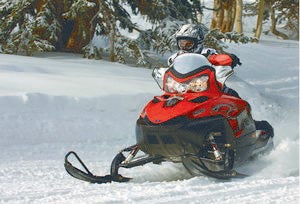
A sled that embraces the real Polaris heritage
In the days of the Indy, Polaris set the agenda. The Roseau, Minn. snowmobile pioneer introduced a new model—and the rest of the sled makers tried to match it. Polaris rode the Indy to nearly 12 years of profitability as Number One in sled sales.
Engine Type:Horizontal In-line
Cylinders:2
Engine Stroke:2-Stroke
Valve Configuration:Reed Valve
Displacement:599 / 36.6
Starter:Pull
Turbocharged:No
View Full SpecSlowly the tide turned. Ski-Doo brought ‘fun’ back to the ride with its REV platform. Yamaha reinvented its snowmobile lineup by focusing on 4stroke power. And Polaris lost its edge. Too many of the same models, too little differentiation. Distracted by becoming a major player in the ATV market, Polaris lost its way in snowmobiling. The Polaris Fusion 900 was the final insult. It marked the bottom. Marketing and engineering faced a humbling future to get Polaris back on top. What could be done to salvage the once-proud line of Polaris snowmobiles?
Admittedly, even after Polaris truly recognized that the Fusion and its all-new 900cc Liberty twin were disasters of its own making, the company had to ride out the first wave of its revamped post-Indy product planning cycle. After the Fusion 900 came a smaller version of the ill-fated Liberty engine to power more new Polaris Fusion-based sleds. There was a 4stroke turbo program that came down with some serious teething issues that drew engineers off future projects to solve current problems with engines in the field. All of this was extremely costly in both dollars and reputation. Where the Indy had elevated Polaris engineering to all-star status in the sport, the Fusion embarrassed them. Fortunately, all was not lost.
Refitting For Success
While the Fusion engine was a total loss, the chassis and suspension systems were salvageable with some rethinking and refitting. The basic Fusion lives on as the IQ chassis. The IQ front suspension gained some major and minor tweaks that led to its becoming one of the most highly regarded designs in the sport. Polaris returned to basic and proven powerplants, such as its 600cc twin, once a leading signature of the Indy’s best sellers. From that came a new high performance 700cc twin. That once problematic 4stroke turbo powerplant survived and is now a workhorse in cruising and touring models. With 140-horsepower, its performance shouldn’t be surprising, but it is. A solid performer the 4stroke shows well in straight-line acceleration and magazine performance shoot-outs.
A Return to What Works
In this ongoing fight to regain its leadership in snowmobiling, Polaris returned to its roots by looking at what worked. The Fusion engine didn’t, but its Cleanfire fuel injection system did. The vibration-prone Liberty 900 rattled the new IQ chassis to submission, but last year’s new 700cc two-stroke twin didn’t. Fitted into the tweaked IQ chassis the 700 twin became a new sporty snowmobile.
Then, building on snocross success, Polaris named its new performance sled the Dragon and began a major comeback year. The Dragon gained very positive press that made it a “must have” ride. This year Polaris drops its proven 600cc twin into a Dragon platform to create a sled that fits smack into the heart of the sales market—600cc sports twin Where the 700cc Polaris niched between the best selling Ski-Doo REV 800 and 600, for 2008 Polaris goes head-to-head with all comers with the Dragon 600.
The Dragon enters a heavily competitive slot. If life were fair, the Dragon 600 would get all the hype. But Ski-Doo’s REV-XP relegates the Dragon to being last year’s news. But nothing can take away the fact that the Dragon 600 is based on a very good IQ chassis and is a suitable smaller displacement kin to last year’s very popular Dragon 700.
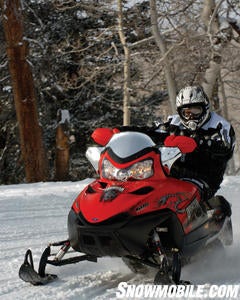 The IQ suspensions and chassis make the Dragon a good choice for rough trails.
The IQ suspensions and chassis make the Dragon a good choice for rough trails.
Let’s accept a bit of engineering reality. In 2007, the 600 IQ was a predecessor to what is now the Dragon 600. You’ll find two versions of its 600cc motor. One is the basic twin-carb engine, as you’d find in the 600RR and Shift. That version delivers 120hp. The other, and our first choice, is the Cleanfire 600 with five more horsepower. If you plan to make any engine mods, opt for a sled with the carbureted twin. Hey, that’s really why Polaris put it out there. We prefer the Dragon’s Cleanfire version of the Polaris-built Liberty 600 because of its nearly instantaneous throttle response. The system faultlessly reads temperature, barometric pressure and engine need for excellent on-trail performance. Even with the normal loss in power we had at 11,000 feet in the Colorado Rockies, the Dragon 600 maximized its performance from idle to wide-open throttle.
It gets to be a toss-up between the top 600cc two-stroke twins. We like the Rotax 600 SDI in the MXZ chassis a bit better overall, but the Liberty Cleanfire 600 is every bit as good. Cat’s Suzuki-built 600 twin with batteryless electronic fuel injection is a contender, too. On a pure power basis, the Liberty twin with its 125hp should have the edge, though the slightly less potent Rotax gets the nod on power-to-weight thanks to the MXZ 600’s 41-pound lighter REV-XP chassis.
Air 2.0 Suspension
While there will be calibration revisions from last year’s 700cc Dragon to the ’08 Dragon 600, Polaris engineering derives a season’s worth of knowledge from the Dragon 700 as to suspension setup. Plus all Dragon’s gain an exclusive-to-Polaris front shock, the RydeFX Air 2.0. A part of ArvinMeritor, the 16th largest automotive supplier in the world, RydeFX supplies shocks for a variety of powersports applications, including offering exclusive products for Polaris snowmobiles and ATVs. The Air 2.0 is a bit of a misnomer in that it really isn’t an ‘air’ shock but an oil/nitrogen charged gas spring damper that eliminates at least a pound off the Dragon’s front end versus a traditional coil spring over monotube shock.
The unique characteristic of the RydeFX Air 2.0 is its patented oil porting and integrated cylinder design, which incorporates twin gas chambers that provide dual rate spring adjustability. This approach eliminates the need for external gas chambers that are more susceptible to air leakage. The shock’s internal floating piston works with multifunctional gas spring chambers.
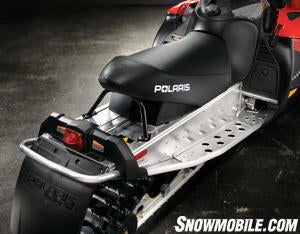 Narrow at the front and wide at the back, the new Freestyle seat improves Dragon ergonomics in 2008.
Narrow at the front and wide at the back, the new Freestyle seat improves Dragon ergonomics in 2008.Within the shock’s 47mm aluminum cylinder, gas spring pressures can be set in a range of approximately 50 -100 psi to accommodate initial shock stroke. The second gas spring chamber is located in the 37mm hardened chrome finished cylinder. This doubles as a durable damper rod to lubricate shaft seals and as an ice scraper as it travels in-and-out of the larger shock body, thereby eliminating excessive friction. This secondary gas chamber within the 37mm rod cylinder can be set in a range of approximately 120-220 psi to control remaining travel in the shock stroke.
Using twin gas spring chambers within a single body configuration combines lightweight responsiveness for high-speed handling and rough trail riding as well as increased ride comfort due to the plusher initial spring rate.
Evolved IQ
With the enhanced performance of the RydeFX shocks, Polaris engineers evolved the IQ A-arm front suspension from the Fusion 900 into a superior unit. Front-end geometry is a strong suit with the IQ design and leads to your ability to hold your line in a corner. The skis provide positive grip to cut sharp turns in virtually all snow conditions.
While there are significant differences between the trailing arm design of the old Indy and the A-arm IQ suspension, the Dragon suspension allows you to make inadvertent mistakes without paying a big price for them. Much like the Indy, the Dragon’s IQ chassis forgives your indiscretion and lets you trust the sled to want to do the right thing. With the old Indy, you could blow a jump and trust the sled to land properly. You can trust the Dragon, too. Credit Polaris for breeding that best of the Indy characteristic into the IQ-based Dragon and utilize the Dragon’s 10-inches of front-end travel by banging over the deep moguls.
The Dragon rear suspension balances the front travel with 13.9 inches of high-pressure gas shock damping. The front shock features an internal floating piston to control damping and rebound. There’s a remote reservoir RydeFX shock on the rear arm of the Polaris slide rail.
Meets Expectations
The end result is exactly what Polaris loyalists expect in a Polaris ‘big bump’ sled. Handling is very positive—consistent and predictable, exactly what you want when riding in the rough. The Dragon 600 corners well, holds your line well, can be readily corrected when necessary and has enough motor to power off the apex. Should you mess up, know that the power of a Polaris hydraulic disc brake is there to get you back in control. Know, too, that Polaris has more experience with hydraulic braking than any other snowmobile manufacturer.
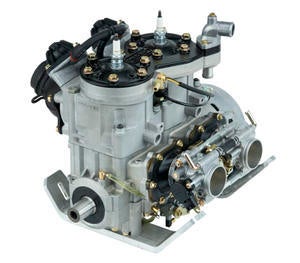 With 125 horsepower the Cleanfire 600 twin works well in the Dragon chassis.
With 125 horsepower the Cleanfire 600 twin works well in the Dragon chassis.
Polaris made some ergonomic changes in the Dragon line. The Freestyle seat is an improvement over last year’s model. It is narrow and firm in the front portion and then widens out into a softer dish at the rear. When standing to ride through rough moguls, the narrower front allows you to ore easily move up to grip the new racing styled flat handlebar. Sit back in the saddle for cruising.
The Dragon is designed to conquer the trail. There’s an aggressive pattern Ripsaw track with 1.35-inch tall lugs. To maximize leverage and control, the handlebar sits atop a 5.25-inch riser and also features adjustable bar-end hooks with wind-deflecting hand guards. Helping the Dragon 600 stand out on the trail are unique Dragon graphics, Indy Red hood and a not-subtle chromed windshield. The Dragon is not for the insecure.
A Return to The Polaris Heritage
The Dragon is, however, a strong sign that the ill-conceived Fusion, like the infamous Polaris Comet of the mid-1960s, was a once in a generation brain fart that served as a wake up call to Polaris company-wide. Maybe Polaris snowmobiles won’t be Number One this season, but the snowmobile group has gotten back to its roots and is distancing itself from the Fusion and embracing a new Indy-style resurgence led by snowmobiles such as the Dragon 600, a true return to the real Polaris heritage.



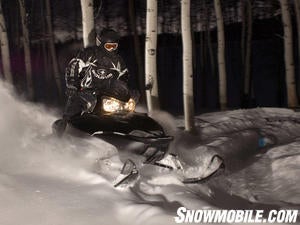
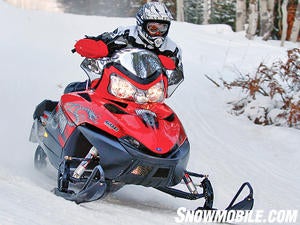
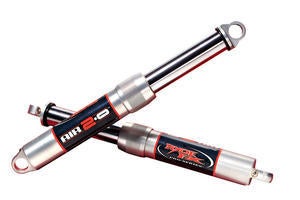

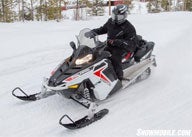
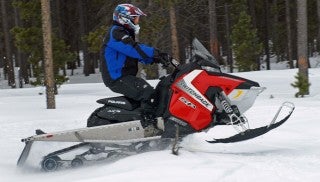


 Your Privacy Choices
Your Privacy Choices